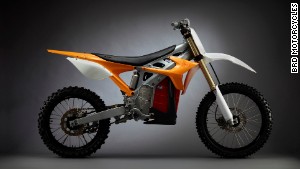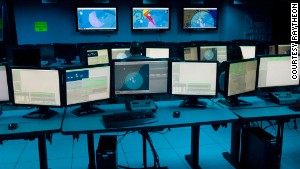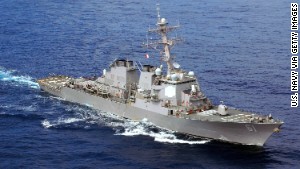Navy's stealth destroyer designed for the video gamer generation
Source: CNN
Much has been written about the Zumwalt's appropriately named commander, Capt. James Kirk.
But aside from that coincidence, the ship's operations center utilizes
advanced technology that takes multitasking to a deadly new level on the
high seas.
First launched last year,
this is a massive $3 billion warship -- the largest type of destroyer
in the modern Navy by about 65%. One thing that sets it apart is a very
small crew.
Compared with about 300 sailors needed for similar warships, the Zumwalt's minimum compliment is only 130.

Pentagon's platform for stealth dirt bike
The smaller crew is made
possible by advanced automated systems which "make it much easier and
much more effective for the sailor to operate," says former Navy Capt.
Wade Knudson, who now serves as Zumwalt program director for Pentagon
contractor, Raytheon.
In the operations center
-- which in many ways is the heart of the ship -- sailors are surrounded
by an array of video displays that have been designed to be used by a
generation raised on video games, Knudson says.
Raytheon tested the
technology configuration in the operation center with young, gamer
sailors, Knudson says. "We've brought them down to our labs and we got
direct feedback from them using human-factor engineers in order to make
sure that we've integrated all the displays and information in a way
that they can use the systems most effectively."
The result, he says, is
less chance of making errors on the ship. "The system and the computer
provide information to the sailor in a way that they're used to."
Work stations inside the
center are outfitted with three common displays, Knudson says. "You can
sit down at any of the systems and operate them."

A Raytheon mock-up of a Zumwalt operations center roughly similar to the facility aboard the Navy's newest destroyer.
At 610 feet long and 80
feet wide, the Zumwalt is about 100 feet longer and 20 feet wider than
ships in the Navy's current fleet of Arleigh Burke-class destroyers
featured in the action-packed 2012 film "Battleship."
Although it's huge, the Navy says this thing is surprisingly stealthy.
Much of the ship is
built on angles that help make it 50 times harder to spot on radar than
an ordinary destroyer. "It has the radar cross-section of a fishing
boat," Chris Johnson, a spokesman for Naval Sea Systems Command, told
CNN last year.
Sean Gallagher, of the self-described "alpha geek" website Ars Technica,
got a chance last year to explore a mockup of the Zumwalt's operation
center. The workstations are part of the ship's Common Display System --
nicknamed "keds" for short, Gallagher reported.
Sailors operate keds
with "trackballs and specialized button panels," Gallagher reported.
Operators have an option to interface by using touchscreens, if they
prefer, according to Gallagher.
The whole operations
center technology array saves manpower by allowing sailors to monitor
multiple weapons systems or sensors, Gallagher reported. The Zumwalt,
Gallagher wrote, also includes limited wireless networking capability.
The way all the ship's
weapons, radar and other systems are displayed to users and the captain,
Knudson told CNN, "it really give them unprecedented situational
awareness."

The Zumwalt is about 100 feet longer than older Arleigh
.
Burke-class destroyers like this one, the USS Ramage.
"That ability is truly going to be a game-changer."
In its current
configuration, the Zumwalt will carry a considerable arsenal of weapons,
including two Advanced Gun Systems (AGS), which can fire
rocket-powered, computer-guided shells that can destroy targets 63 miles
away. That's three times farther than ordinary destroyer guns can fire.
But one day it could be
fitted with advanced weapons systems that are currently experimental,
including a laser weapon and an electromagnetic railgun.
Electromagnetic railguns
don't need to fool around with needless explosive warheads or
propellants. These fearsome weapons inflict damage by sheer speed. The
gun uses electromagnetic force to blast a missile 125 miles at 7.5 times
the speed of sound, according to the Navy.
The laser weapon --
which could be fired by one sailor on a video game-like console -- is
designed to take on aircraft or small surface vessels.
Currently undergoing sea testing, Knudson says the Zumwalt is expected to join the rest of the Navy fleet sometime in 2016

No comments:
Post a Comment